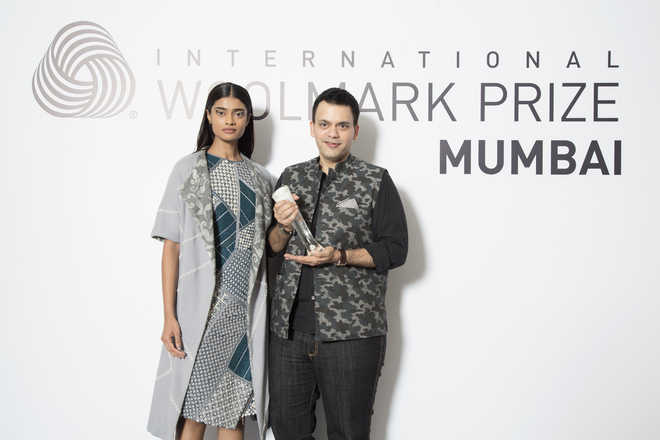
Nachiket Barve’s creation — sheath dress with reversible jacket — that won him the IWP region award
Ashima S Batish
You expect a thrill in the voice on the other side of the phone — a warm hello that exudes confidence, gives a hint of triumph. And a “Hello” follows, which is so customary that you confirm if Nachiket Barve’s number has changed. “Hey. It’s me only,” he confirms. Nachiket and Delhi-based Kashmiri designer Zubair Kirmani have just won the International Woolmark Prize (IWP) India, Pakistan and Middle East Regional finals. But celebrations, Nachiket says, will only happen after the final bout in January 2017.
Till then, there is a lot of work to do. “Seems like the whole world is watching but I don’t want to get carried away by the adulation. Work I must, and a lot of it.” Excerpts from the interview, where Barve talks about his recent success and what else he aims for.
You have been in the fashion industry for so long and your talent has been applauded often. Where do you place the International Woolmark Prize of the region amid all other accomplishments?
Mine is still a very young label and there is a long way to go. The International Woolmark Prize of the region has brought us incredible international visibility, but the real journey begins now. The global fashion market will now start analysing my creations. I can’t rest on past laurels. While the Prize is the fillip that I and my workforce needed, at the same time, it has made us realise our responsibility towards the judges and fashion followers, who have reposed faith in us.
Two Indian fashion designers have bagged the award for consecutive years. Does that put any pressure on you?
Not really! It’s an honour to get nominated for the finals of the IWP. The prize puts you in the spotlight. Fashion followers grow aware of your work and the fashion industry visualises your success as theirs. You can either feel motivated by the achievement or feel the pressure. For me, winning the finals would be the high point of my life but not making it wouldn’t distress me either.
Wool in India was never an all-weather product until Indian designers started experimenting with it. How are you working with it to reintroduce it to the mainstream fashion market?
Wool has been extensively used in North India. Beyond the North, where it is a part of the culture, it’s only used when on a vacation to the hills. My endeavour with the collection was to reintroduce it as an all-weather, all-occasion wear. To present it in a way that geography or climate of a place doesn’t decide its utility. Even in the North, it is considered more of a formal wear; nobody reckons it as an evening do that guarantees sensuality. My collection aimed to flip wool to highlight its elegance.
Your earlier collections have limited the silhouettes to western cuts. Do you intend to tread the same path?
Whatever I create is the outcome of a eureka moment. If an idea occurs to me and I am convinced with its success, I go ahead. If someday I will feel the same about a bridal line, I might contemplate about it. As of now, that isn’t in the scheme of things. So, the label, Nachiket Barve, branches out into three different lines. The first has an international appeal that is also ideal for media coverage. Second is western prêt, which comprises silhouettes like tunics, long shirts and kurtas and third is occasion wear, which is every bit customised. To begin anything new, it has to come from within.
For the particular competition, what techniques did you use and how did wool fit into the design scheme?
As a designer, I play with the material. When it comes to wool, I have worked with the yarn, fabric and feel of it. What made me win the IWP for the region is a structured sheath dress with a reversible jacket.
Now that two Indian designers have won the competition, and fashion followers are betting on you, do you think Indian fashion industry is being adequately represented internationally?
India has always been a hotbed for outsourcing embroidery and material. But when it comes to international consumption of our designs, we are a micro-blip in the billion-dollar industry. Labels like Gucci or Valentino not just sell well in the country of production, also across the world. Clients from various countries relate to the design aesthetics. Do we want to be there and emulate the success of international labels or be happy in our own space is another thing. The fact, however is, the Indian fashion industry has not made a global impact yet.
Sustainable fashion is the new buzzword that has replaced organic fashion. How do you correlate sustainability and fashion, when trends change each season?
I abhor wastage. Making organic designs and consuming these in large quantities won’t serve the purpose. Fashion industry’s part of solution to climate change would be making clothes that don’t become disposable after a year. These should look as chic even when worn after a decade. We need to use better material and techniques to makes clothes last longer.



























